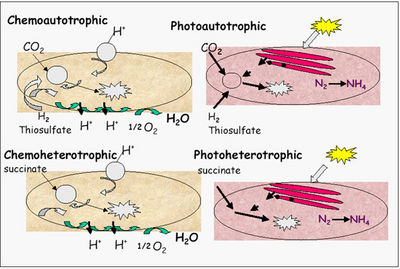This study's objective is to analyze what times of
feeding and withdrawal of residual waters on the treatment tank are optimal for
their treatment by means of purple non-sulfur bacteria.
 |
| Wastewater treatment plant |
This is a photosynthetic tank treatment, which is a
kind of high-yield oxidation tank treatment. This treatment was selected due to
the use by purple non-sulfur bacteria of VFAs (volatile fatty acids) as
substrate, which reduces the generation of odorous gases and greenhouse effect
gases that tend to be found specially on the 1st tank in the conventional
chain.
This process also presents other advantages, such as
the use of the cellular mass of purple non-sulfur bacteria as manure, fish
feeding or agricultural substrate.
The purple non-sulfur bacteria can grow together with
acidogenic bacteria in microaerobic or anaerobic conditions. And if they are
maintained as the dominant this is preferable on constant illumination
conditions, as it eliminates the need for a pretreatment (reducing the
generation of greenhouse and odorous gases).
The acidogenic bacteria are necessary because they
generate the first reactive needed by the purple non-sulfur bacteria. Allowing
their quimiotrophic growth by acidogenesis on the dark phase if the
illumination isn't constant. Though this generates methane synthesis.
 |
| Rps. Palustris |
The feeding and withdrawal of fecal waters in the tank
can be an important factor in the state of bacterial communities and the
process' yield. As it regulates the flux of nutrients in the media.
The bacteria used for this experiment was Rhodopseudomonas palustris. As it doesn't
use glucose for carbon source, facilitating the identification of the changes
in the media generated by the other microorganisms.
To check under which conditions a higher yield is
obtained 3 different pathways were followed: Feeding at the beginning of the
luminous phase and withdrawing at the end of the dark phase. Feeding at the beginning
of the dark phase and withdrawing at the end of the luminous one. And feeding
at the beginning of the luminous phase but withdrawing at the end of it.
A glucose medium was used as simulated wastewater
along with a vitamin solution and the metallic probe.
The tests realized for measuring the yield were DOC
and TOC (dissolved organic carbon and total organic carbon) which are a good
indication of the reactions made by the different bacteria.
A microalgal growth was observed to be a factor in the
diminution of purple non-sulfur bacteria, which makes it's inhibition necessary
for the stable use of said bacteria. For that the use of infrared rays or
filters for the reduction of ultraviolet-visible radiation are suggested.
It's not essential to realize an acidogenic
pretreatment independently, due to Rps. palustris' capacity to grow on a
metabolite mixed culture environment through the use of acidogenic bacteria.
The production of monocellular proteins was as it's higher when the residual
waters were fed at the begining of the luminous phase, without any difference
on when they are withdrawn. Wich makes this feeding the optimal.
Authors: Cristian M. Segura Rodríguez,
Marta Juan Ordás, Javier Palomares Laguna, Jose Antonio Torres Llopis y
Alejandro Quiles Campoy
Bibliografía:
Ryo Hondaa, Kensuke Fukushi, Kazuo Yamamoto
Optimization of wastewater feeding for single-cell protein production in an anaerobic wastewater treatment process utilizing purple non-sulfur bacteria in mixed culture condition
Integrated Research System for Sustainability Science (IR3S), The University of Tokyo, 7-3-1 Hongo, Bunkyo-ku, Tokyo 113-8654, Japan
Environmental Science Center, The University of Tokyo, 7-3-1 Hongo, Bunkyo-ku, Tokyo 113-0033, Japan


No hay comentarios:
Publicar un comentario